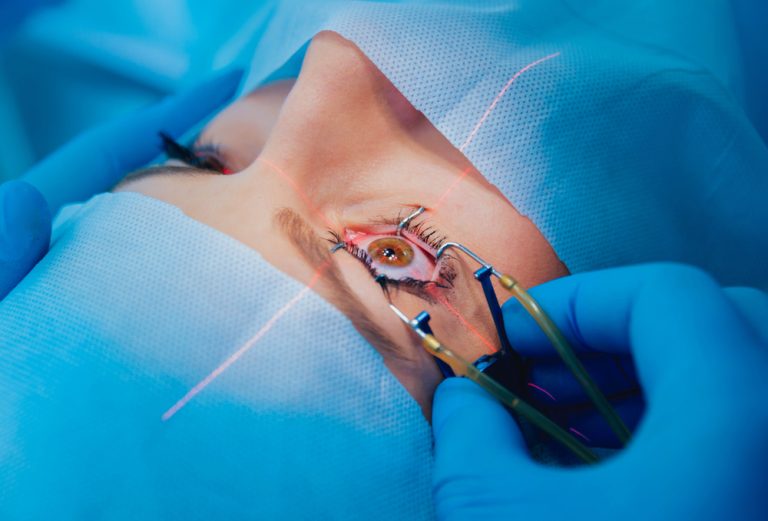
LASIK, or Laser-assisted In Situ Keratomileusis, is a vision correction procedure designed to reduce the patient’s dependency on glasses or contact lenses. Using a laser with high precision, it reshapes the cornea to improve focus.
Who is a candidate for LASIK?
LASIK is an ideal procedure for individuals over the age of 18 with stable vision and healthy eyes and free from conditions such as cataracts or severe dry eyes. Candidates typically have common refractive issues such as myopia (nearsightedness), hyperopia (farsightedness), astigmatism, or presbyopia (age-related). A consultation before the surgery is usually done to assess the patient’s eligibility for this type of surgery.
Pre-surgery preparation
Before undergoing the procedure, as mentioned before, a detailed pre-operative consultation is required to ensure the procedure is safe and effective for the conditions of the patient. This includes a comprehensive eye exam to measure corneal thickness, pupil size, and refractive errors. The doctor may map the corneal surface and check for dryness in the eye or other conditions.
They will discuss the surgical plan based on the patient’s medical history, lifestyle, and expectations from this surgery. To avoid altering the corneal shape it is mandatory to stop wearing contact lenses before this appointment.
Your ophthalmologist will also advise you to stop using lotion, makeup, or perfume near the days of the surgery to avoid the products getting in your eyes and increasing the risk of infection.
Surgical procedure
The LASIK procedure consists of many steps, such as:
- Numbing the eye:
- Numbing drops are applied to the eye to ensure the procedure is not painful
- The patient may feel slight pressure, but no pain
- Numbing the eye:
- Positioning the eye
- A suction ring and eyelid speculum are placed on the eye to keep it steady and in place and also to prevent blinking.
- Vision may dim temporarily and the patient might feel slight pressure.
- Creating the corneal flap
- The surgeon creates a thin flap on the cornea, which is then gently lifted and folded back.
- Reshaping the cornea:
- The patient will be asked to focus on a light as the surgeon uses a laser to reshape the cornea.
- The laser makes clicking sounds, a distinct smell is also noted which is due to a chemical reaction that occurs during corneal reshaping.
- Tracking softwares measure your eye’s position 500 times per second, ensuring it is highly precise and pausing the laser if the patient moves.
- Repositioning the corneal flap:
- The corneal flap is placed back in its original position where it begins to reattach and continues to heal post-operation.
This entire procedure should only take approximately 30 minutes in which the patient will be awake throughout.
Post-surgery procedure
As this is an outpatient procedure, the patient can go home directly afterwards. The surgeon will provide you with a shield to protect your eyes from dust, infections, and touching that could disrupt the healing process. The doctor will also provide you with a prescription for eye drops to prevent dryness, antibiotic eye drops, and steroidal eye drops for inflammation.
The patient will have a follow-up appointment 1 or 2 days after the procedure to check the healing process and to assess any complications.
Mumbai is known for its reliable LASIK surgery with skilled doctors and advanced care. For the best LASIK treatment in Mumbai, the city offers precise procedures using advanced technology and experienced doctors to achieve clear vision.
Risks associated with LASIK
Though loss of vision is a rare complication, there are some side effects of LASIK that are common such as dry eyes, temporary glare problems and so on which usually clear up in a few weeks post-surgery. Some other risks include:
- Under corrections: if the laser removes too little tissue from the patient’s eye, they will not get the clear vision they hoped for.
- Over corrections: If the laser removes too much tissue from the patient’s eye. This may be a little difficult to fix.
- Astigmatism: due to uneven tissue removal.
- Regression: When your vision returns to the same state as before the surgery. This is less common.
- Corneal ectasia: a serious complication that occurs when a weak thin cornea loses its shape causing bulging and vision deterioration.
Benefits of LASIK as compared to other procedures
LASIK has become a popular choice for vision correction as it is a safe and effective solution for conditions such as myopia and hyperopia. Compared to traditional methods, LASIK provides distinct advantages, making it a preferred option. Here are some of the benefits:
- Quick recovery: Patients experience the results of the surgery as early as 24 hours after the procedure.
- Painless and precise: High precision and minimal discomfort are observed in this procedure.
- Long-lasting results: LASIK offers a permanent correction for vision conditions.
LASIK offers a life-changing solution for those seeking clear vision with a quick recovery, high precision, and minimal discomfort. While it is not suitable for everyone’s conditions, this procedure’s precision and effectiveness make it a trusted option.


